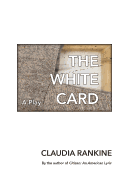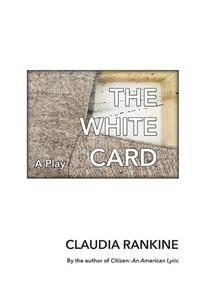
 Claudia Rankine is, among other things, a poet best known for the National Book Critics Circle Award-winning Citizen: An American Lyric. The White Card is her first published play, a one-act drama composed of two scenes. The first scene is set at a dinner party hosted by Virginia and Charles, a philanthropist and art collector. The dinner's guest of honor is Charlotte, an up-and-coming black artist whom Charles wants to feature.
Claudia Rankine is, among other things, a poet best known for the National Book Critics Circle Award-winning Citizen: An American Lyric. The White Card is her first published play, a one-act drama composed of two scenes. The first scene is set at a dinner party hosted by Virginia and Charles, a philanthropist and art collector. The dinner's guest of honor is Charlotte, an up-and-coming black artist whom Charles wants to feature.
In the preface, Rankine writes that the play was inspired by a middle-aged white man at a question-and-answer session who asked her: "What can I do for you? How can I help you?" and his dissatisfaction with her answer: "I think the question you should be asking is what you can do for you." The play approaches the difficult reality of people who "read all the relevant books on racism, see all the documentaries and films... but in the moment of dialogue or confrontation retreat into a space of defensiveness, anger, silence, which is to say he might retreat into the comfort of control...." As the evening progresses, Charlotte and the couple's young, activist son, Alex, critique Charles's white-savior position in the art world, pushing him out of his comfort zone until he retreats to the reflexive, defensive posture described by Rankine.
The heart of the play is, of course, the conversations, which, other than the highbrow tone set by the art world association, might be familiar to many readers. The White Card is far beyond a simple polemic; each character is well-realized, with a distinct perspective. Virginia's desire to keep things calm and polite ("I ask Charles this all the time, why would you want to subject an audience to these horrors?") conceals a deep discomfort with what has befallen her older son. The family's political strife comes to be seen as inextricable from their personal strife, the fault lines present well before Charlotte's arrival. Meanwhile, Charlotte must contend with the ways her work is patronized and experienced, especially when it's revealed that part of Charles's real estate fortune was earned building private prisons.
The second scene continues Charles and Charlotte's conversation one year later, in her studio. Tensions heighten as Charlotte attempts to make him see himself as part of the ongoing tragedy of race in the United States rather than a separate, impartial observer.
The White Card stands out due to the realism of its discourse. It manages to be a provocative work without straw-manning other perspectives. When Charles says, "I truly am trying to find a way through," it's easy to believe him, even if his motivations are confused and flawed. The play also documents Charlotte's changing answer to the question: "What does it mean to portray black suffering as art?" The question is put forth in the first scene, when Charles and Virginia dramatically present an addition to their collection: a photograph of Michael Brown's autopsy report.
The White Card stages difficult conversations around race, art and guilt that are too frequently avoided. --Hank Stephenson, bookseller, Flyleaf Books, Chapel Hill, N.C.
Shelf Talker: The White Card is a one-act play where a dinner party held in honor of a black artist turns to difficult questions about art and race.

